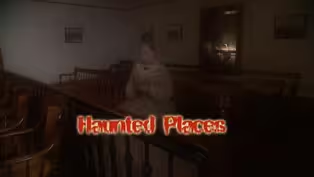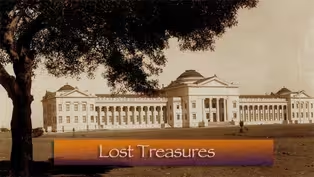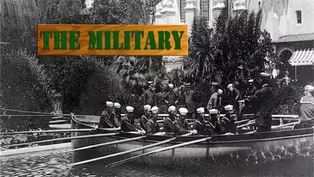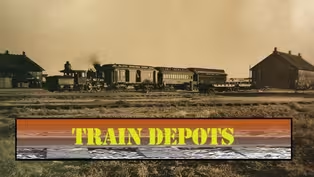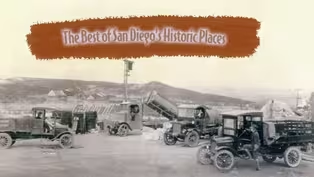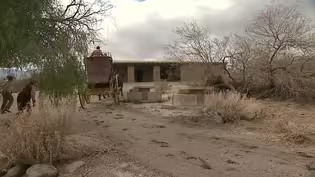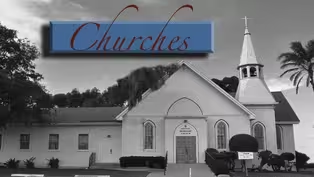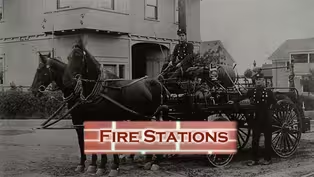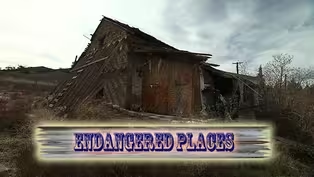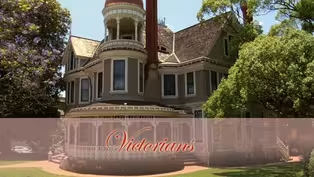
Century Old Sites
5/16/2013 | 26m 48sVideo has Closed Captions
There are historic buildings, bridges, sites and organizations turning 100-years old.
There are numerous historic buildings, bridges, sites and organizations around San Diego that are turning 100-years old. We'll show how the San Diego Girl Scouts, the historic Spreckles building, the Julian "Six Footers" Baseball team and others are celebrating their Centennials.
Problems playing video? | Closed Captioning Feedback
Problems playing video? | Closed Captioning Feedback
Historic Places with Elsa Sevilla: California's History is a local public television program presented by KPBS

Century Old Sites
5/16/2013 | 26m 48sVideo has Closed Captions
There are numerous historic buildings, bridges, sites and organizations around San Diego that are turning 100-years old. We'll show how the San Diego Girl Scouts, the historic Spreckles building, the Julian "Six Footers" Baseball team and others are celebrating their Centennials.
Problems playing video? | Closed Captioning Feedback
How to Watch Historic Places with Elsa Sevilla: California's History
Historic Places with Elsa Sevilla: California's History is available to stream on pbs.org and the free PBS App, available on iPhone, Apple TV, Android TV, Android smartphones, Amazon Fire TV, Amazon Fire Tablet, Roku, Samsung Smart TV, and Vizio.
Providing Support for PBS.org
Learn Moreabout PBS online sponsorshipMore from This Collection
San Diego's Historic Places is an Emmy-Nominated and Award-Winning documentary series hosted by journalist Elsa Sevilla. Elsa connects viewers to the region's past as she explores historic sites, museums, cemeteries and parks and chats with local experts on the various people who lived there.
Video has Closed Captions
The most popular haunted historic sites in all of San Diego. (25m 46s)
Video has Closed Captions
Learn about the lost historic treasures throughout the county. (26m 16s)
Video has Closed Captions
We look at historic train depots throughout the county; from downtown to National City. (25m 45s)
Best of San Diego's Historic Places II
Video has Closed Captions
Best of San Diego's Historic Places (26m 47s)
Video has Closed Captions
The Mexican Families of Old Town's early years. (26m 46s)
Video has Closed Captions
Historic churches from around the county, from Old Adobe Chapel to Mission Basilica. (25m 49s)
Video has Closed Captions
See the oldest fire stations in San Diego and learn the history of the SD Fire Department. (26m 16s)
Video has Closed Captions
A look at some of San Diego's historic and most beloved theaters. (27m 5s)
Endangered Historic Sites in San Diego
Video has Closed Captions
Learn about some of San Diego's most endangered historic sites. (26m 24s)
Video has Closed Captions
Visit some beautiful Victorian Houses located in San Diego. (25m 47s)
Providing Support for PBS.org
Learn Moreabout PBS online sponsorshipElsa Sevilla: Coming up next on "San Diego's Historic Places."
The beautiful historic Spreckels Theatre and building are 100 years old.
We'll show you what's being done to restore and preserve the building.
The Girl Scouts of America are celebrating their centennial celebration.
Find out how San Diego's chapter got started and who was involved with its early beginnings.
As celebrations for Balboa Park are in the works, the historic Cambria Bridge is coming up on 100 years.
We'll show you rare historic photos of the construction from 1914.
And the Julian baseball team was established since the 1880s.
You'll see rare historic photos of the team that are just turning a century old.
Those stories are coming up next.
♪♪♪♪♪ male announcer: Thank you to SOHO, Save Our Heritage Organization for its partnership.
SOHO is preserving San Diego's history for the future.
Elsa: Thank you to the San Diego History Center for their continuous partnership and the use of their historic photos.
For more information, go to their website, sandiegohistory.org.
♪♪♪♪♪ ♪♪♪♪♪ Elsa: Hello and welcome to "San Diego's Historic Places" where you learn about the county's history.
I'm Elsa Sevilla.
Thanks for joining us.
Whether it's a historic neighborhood, an organization, a bridge, or a baseball team's historic photos, there are numerous sites around San Diego, turning 100 years old, and others that just celebrated their centennial.
In the next half hour, you'll learn and see wonderful sites around San Diego that have stood the test of time, and have made it past 100 years.
We began with a beautifully restored historic Spreckels Theatre and building in downtown San Diego.
Elsa: The beautifully restored historic Spreckels Theatre and building is one of the most recognized in San Diego.
It was originally built to coincide with the Panama California Exposition of 1915.
The Spreckels was built a couple of years before the exposition and has just celebrated its 100th birthday, August 2012.
Ms. Jackie Littlefield has owned the Spreckels for half a century.
Jacquelyn Littlefield: So I said we gotta buy that building because it is all that's left on Broadway of something really important.
And I really did it for my dad.
I wanted a heritage for the family.
Shaun Davis: There is a lot of history just encapsulated in this building.
When you really look at it, it really is kind of a time capsule of 100 years ago.
When you walk through the doors, you're seeing some of the same things that people saw 100 years ago.
Elsa: Because of its 100th birthday, the Spreckels has recently undergone interior and exterior restoration.
A lot of research went into getting the historically accurate design and colors of the marquee and blade sign.
John Blake: We started scraping, and digging through it, and pulling up colors, and we created the designs basically from what we found.
So that's how it became, you know, this, which is what it was back in the '30s.
Elsa: John Blake, along with Ms. Littlefield have led the team of experts in restoring the marquee and blade sign, which are 99% original.
Some pieces haven't been disturbed in nearly 80 years.
John: You've got fluorescent lighting in behind the changeable panel.
You know, there might be 30, 40 fluorescence all the way around.
We've got the old incandescent bulbs running across the bottom, and probably about 300 or 350 pieces of neon between the marquee and the blade sign.
Elsa: The task was challenging, but John and his team were prepared.
He found a historic treasure that had been covered for decades.
John: That was probably the biggest discovery.
We used to be completely covered with stucco, and ink, and recess lighting.
And once we got in there, we found that glass ceiling that you were down there.
And we basically restored that framework and that glass ceiling.
Shaun: We have had our "Relight Broadway Program" where we've redone our marquee and blade sign out in the front.
We also, with the help of American Seating, we've got new in standards on the seats, and new seating upstairs in the mezzanine.
And if you look at the cast iron in standards, they are very age appropriate for this type of a building, but they have something very special in it that we're very proud of.
The valance that's actually above my head that you can't see right now is 100 years old.
Elsa: While the building is 100 years old, the Spreckels has been in Ms. Littlefield's family for 50 years.
It was her father, Louis B. Metzger, a Hollywood movie pioneer who worked for Universal and Warner, who first leased the building.
Metzger had the vision of providing films for the independent theaters in San Diego, and then stumbled onto the Spreckels.
Jacquelyn: He got together with the boys, the Warner brothers, Sam, and Harry, and Abe, and United Artists and all of the group.
And where do you think the best spot would be for little independent operator?
And they ended up giving kind of a consensus on San Diego.
Elsa: While Metzger leased the building for many years, Ms. Littlefield would purchase the Spreckels to honor her late father's legacy.
The building has been in the family ever since.
Shaun: And it had a long history as a movie house, which is when Mrs Littlefield's father took over the lease hold on the building.
That was Louis B. Metzger.
And then Ms. Littlefield bought the building.
This is all--we are at our 100th anniversary and she is at her 50th anniversary.
Elsa: Through the years, the Spreckels has been faced with demolition plans, but Ms. Littlefield wouldn't have it.
She's held on to the Spreckels to preserve it and honor her family.
She's been the Spreckels guardian if you will and plans to care for it for future generations.
Shaun: She knew then just intuitively that this needed to be preserved for not only for her family as a legacy, but for San Diego as a legacy.
And they have really done an excellent job safeguarding it.
Elsa: The Spreckels Theatre and Building are busier than ever.
There are several floors filled with office space and the theater is beautiful and has held countless plays, musicals, rock bands, comedians and so much more.
The family hopes to keep it going for generations to come.
Elsa: The San Diego Girl Scouts are celebrating their roots, which started at the turn of the 20th century.
What began as an organization for hundreds of girls from all backgrounds has evolved into a 3 million girls strong national organization.
The outdoors and camping was the basis of getting girls in touch with nature, and allowing them to explore new things.
Elsa: The Girl Scouts of America started as an organization to empower girls and women at the turn of the 20th century, at a time when society didn't acknowledge women's rights.
Juliette Gordon formed the organization in her hometown of Savannah, Georgia.
While the National Girl Scouts are celebrating a century, the San Diego Chapter will soon be coming up on its centennial.
Marlene Williams: They started actually out of the YMCA on C street in 1917.
And from there, they went to the Sefton building and they were there for a few years, and they grew in numbers, and started what we know today.
Elsa: The history of the San Diego Girl Scouts has been carefully documented through photos and newspaper articles through the decades.
Soon after 1917, troop one in Coronado was formed, and a few months later, another troop one was organized in Fallbrook.
Other early troops were quickly forming and becoming very active in San Diego County.
Marlene: They had-- Roosevelt had a nice troop.
They were very active and then they had the Gray Castle Troop at San Diego High.
Loma Portal which used to be Point Loma, had their troop.
And Mission Health and there are several trips in the area.
Very popular.
Elsa: By the first year, the girl scouts quickly grew to 100 girls.
Historic photos show how girls enjoyed camping and the outdoors.
Marlene: From the origins, they want it to be for all girls everywhere.
And so they set it up so that girls from all of the social economic backgrounds could participate.
It's just really amazing.
They didn't have to do that, but that's what they wanted from the very beginning.
Elsa: It took women from all backgrounds to get the local chapter started.
Many were the wives of San Diego's leaders.
Marlene: The women were amazing.
They were absolutely amazing.
We have Marion Kettner that I mentioned and Florence Burnham, she was in from the origins.
We have Mrs. Fisher, Mrs. William Fisher, and Mrs.
Hazard, Mrs. O'Rourke.
Elsa: As the local organization grew, the girl scouts needed a permanent location and they found space in the Adobe Building left vacant by the Panama California Exposition of 1915.
The women secured a spot in the Adobe Building in 1919.
Marlene: This is from the first "Girl Scout Rally."
It was May 31st, 1919, and the dates on there, rally of the be prepared girls of San Diego County, California, and our first executive director, Ms. Nancy Wodel, is here in the center.
And we have Coronado Troop Number One, Fallbrook Troop Number One.
And then we have a group from San Diego and then Lemon Grove.
Elsa: By 1922, the group would move to the beautiful Pepper Grove site also in Balboa Park.
Sadly, the building wouldn't survive.
It was torn down, but the adjoining building in Balboa Park, the Lawrence Burnham Hall, was also used by Girl Scouts.
It was saved and moved to the current Girl Scouts location on Upas near the San Diego Zoo in the 1950s.
The historic Burnham building is a century old.
It is still in use today.
Photos help tell the Girl Scouts's story of nearly a century ago.
It shows the many transitions through the years.
I like this one--totally caught my eye just because of the cover.
What year is this from?
And what is it?
Marlene: This is one of two scrapbooks from Mrs.
Hazard.
This--actually the librarian put this together for her.
Elsa: The Girl Scouts would acquire other property, some in the North County, and more in the East County near Julian.
Through the decades, the local chapter attracted noticeable visitors, including the National Girl Scouts Board during the 1915 Exposition in Balboa Park.
And also President Woodrow Wilson would make a visit and meet the Girl Scouts, and there was Lady Betty Powell who also attracted many during her visits to San Diego.
Marlene: The World Chief Guide was Lady Baden-Powell and she was married.
She was the widow of Lord Baden-Powell.
They started, he started Boy Scouts and then Girl Scouts in Great Britain.
And after his death, Lady Baden-Powell started traveling the world as the Chief World Guide, and she made five visits to San Diego.
And this is one in particular, 1965.
And she, there was a ceremony at the Oregon Pavilion.
Elsa: Today, Girl Scouts of America is more than 3 million girls strong.
The Girl Scouts Centennial Celebration is being recognized nationally, and in San Diego too.
What started out as an organization to empower girls continues strong, 100 years later.
The mission is still the same: to empower and prepare girls for a bright future.
There are other historic sites in San Diego that will soon be celebrating their centennial, including the Cabrillo Bridge named after Juan Rodriguez Cabrillo, the European explorer who discovered San Diego and the West Coast in 1542.
Plans are already underway to celebrate a historic landmark visited by millions of San Diegans and visitors.
The historic Cabrillo Bridge will soon be celebrating its centennial.
In 1914, it was built primarily for pedestrians who would be attending the Panama California Exposition of 1915.
A bridge was needed to get the thousands of Exposition visitors from the uptown area of San Diego to Balboa Park.
Marty Rosen has extensive of knowledge and has worked on current plans to retrofit the bridge.
Marty Rosen: People were going to be coming from the west, from the train station, and being brought up here.
So the bridge was designed to be the main gateway entrance to the Exposition and actually is considered to be probably the most significant bridge in California as a gateway structure.
Elsa: At the time, San Diego leaders wanted an event that would put San Diego on the national and international map.
The Panama California Exposition was used to do just that, and also to celebrate the opening of the Panama Canal that would bring commerce and visitors to San Diego.
Marty: San Diego was looking to do something big to celebrate the opening in the Panama Canal.
And there was kind of a competition going on between San Diego and San Francisco.
And and they both decided to hold expositions in 1915.
Elsa: While thousands travel the bridge daily, you know what it took to build the Cabrillo Bridge starting in 1912.
Historic photos show what the construction looked like a century ago.
Frank Allen Jr. and Thomas Hunter were selected to design the Cabrillo Bridge.
We know it took thousands of redwood trees from Northern California to establish the concrete foundation, the piers, and the structure.
Marty: The design for the Cabrillo Bridge, it's my understanding, was taken from a kind of a Roman aqueduct in Europe.
I've heard it say between Romans and the Moors, but to me, it looks very much like what you would have is is an aqueduct, a viaduct, actually, used in Roman days to transport water.
Elsa: Another fact few San Diegans know about is the pond at the bottom of the canyon that served as an attraction during the Exposition.
It allowed visitors to take gondola rides in the pond.
Photos show how people enjoyed the attraction.
This of course was only many years before the Cabrillo freeway or State Route 163 was built and completed in 1948.
Marty: Caltrans has actually done a historic inventory of all the bridges of California.
And our Cabrillo Bridge is in the top five in rating among the state because of its historical significance, the role it played in the history of San Diego in the Panama California Exposition.
Elsa: The bridge's design is innovative, the first of its kind in California.
The length of the bridge is 916 feet, which includes the bridge's approaches, while the main span of the bridge is actually 450 ft.
There are seven arches supported by 14 hollow concrete pillars.
The cost of the bridge then was $250,000.
Today, that would translate to nearly $6 million.
Marty: So we already knew that the bridge was significant.
It's part of the El Prado National Register District.
It's part of the national historic landmark for Balboa Park.
It is a contributing bridge to National Register eligible Cabrillo Historic Parkway.
Elsa: The Cabrillo Bridge has seen millions of visitors, and some wear and tear through the years.
Caltrans has been conducting an extensive seven year historical research to begin a retrofitting and restoration project soon in time for the bridge's centennial in 1914.
Marty: You start early and you bring all the experts together.
And right away, you know, okay, the goal is to make this seismically strong to withstand a kind of a worst-case scenario earthquake, and then to rehabilitate all the concrete so that it doesn't fall off down below, or deteriorate to the point where it affects the internal integrity of the bridge.
Elsa: The reflecting pool at the bottom of the bridge is gone.
State Route 163 was built for increasing traffic in the 1940s.
The freeway also allows San Diegans and visitors a great vantage point to enjoy the historic bridge.
The bridge will be celebrating 100 years.
The celebration plans have already begun.
Next, an exciting story is a historic Julian Baseball team is set to celebrate 130 years of history in the gold mining town in the East County.
Recently, one of the town's historians made an incredible find and it could be worth more than gold.
The findings included three rare historic photographs of the town's baseball team.
One of those photos just turned 100 years.
Elsa: The historic town of Julian was founded in 1870, after the first and only gold rush in San Diego County.
It would take another 14 years or so before the town formed its own baseball team known as the Julian Six Footers.
A rare historic photo shows the first known Julian Baseball team from 1884.
This rare treasure from the past and two other historic photos were discovered by one of the town's historians, Ed Huffman.
Ed Huffman: I came across a folder that said "Baseball," deep down in a file drawer.
I opened it up and to my surprise, there were photographs of old Julian baseball teams.
They were from 1886, 1910, and 1912.
Elsa: Ed made the discovery in spring 2012, during his research at the Julian Pioneer Museum.
He discovered something worth more than the gold found in Julian since the late 1800s.
The discovery was made just in time to celebrate one of the team's many accomplishments.
Ed: It was 1912 baseball team.
It was 100 year anniversary.
The 1912 baseball team in the photograph was posed in front of a 1912 Mac Motor Stage truck.
The Julian Historical Society now owns that vehicle.
It's been completely restored and we got the idea to make a commemorative poster in commemoration of at least 100 years of baseball in the town of Julian.
Elsa: What a wonderful treat.
Ed takes us to see the beautifully restored 1912 Motor Stage truck used in the 1912 Julian baseball team's historic photo.
Take a close look at the photo.
It's hard to see the truck.
It's so much larger up close.
My son Julian and daughter Sammy get a personal tour and history lesson from Ed.
The truck has been restored after the late Richard Dick Zerbe discovered many of the truck's parts and surrounding areas scattered, but take a look at what became of the truck before the restoration.
Incredible.
Ed: In our research, we were able to go back to 1884.
The Julian baseball team won the San Diego County baseball championship in 1884.
We have the photo from the 1886 team.
There's an article in the San Diego Union in 1984 that was also in the folder at the museum here.
Elsa: The Julian Six Footers won the 1884 San Diego County Championship.
The team would win the title again in 1914 against El Cajon.
If you look closely at the historic photo from 1910, you can see the catcher with the catcher's mask.
That mask was donated by Mr. Joe Romano to the Julian Historical Society.
Ed: To go back to 1884, we found that the Julian won the county baseball championship.
Come forward to 1914, they won it again.
This character's mask is from the 1914 team.
So it's 99 years old as we speak.
The catcher in 1914 was Royd Walters.
The mask was purchased from Myrtle Watts.
She was the Julian librarian.
Elsa: Nearly 130 years later, the Julian Six Footers are still being remembered to commemorate the 100th anniversary of the 1912 historic photo, the Julian Historical Society, Board of Directors, the Julian High School Baseball team, town members, and baseball member descendants gathered for an historic moment in spring 2012.
Ed: We started to research.
We came up with names of the people depicted.
They were with the-- in the folder.
And then we searched and some of their relatives are still here.
So we decided to make an attempt to duplicate the 1912 photograph with the 2012 baseball team from Julian High School.
Elsa: The history of the Julian Six Footers will continue to live on through the official Julian High School baseball team, with the special historic photos and other memorabilia discovered from that era.
At least five descendants from the early Julian baseball team's players were part of the 100th celebration and commemorative poster.
What a great way to preserve Julian's past.
The historic sites around the county turning a century old include the historic neighborhood of Burlingame in North Park, south of University Avenue and 30th street near the 805 Freeway.
The neighborhood is recognized by its rose-colored sidewalks and beautiful historic homes.
There are about 180 historic homes in Burlingame with various architectural styles such as the craftsman bungalow, the Tudor revival, also the Spanish colonial revival, and others built in 1912.
Construction began just a few years before the Panama California Exposition.
The homes in this cluster was also known as a track of character.
A number of people involved with the Exposition decided to settle in Burlingame during the early years.
The historic neighborhood is celebrating 100 years of history in North Park.
Another historic site in San Diego, the Golden West Hotel on Fourth Avenue near Horton Plaza in downtown San Diego.
The hotel was built by John D. Spreckels.
It was known as the "Working Man's Hotel" for people who work near downtown, obviously.
The construction for the historic Golden West Hotel started in 1913.
It would open for business about a year later in 1914.
Historic photos show what the process looked like.
Today it is still being used as a single room occupancy for low-income retirees now.
There are still many features of the early years still present.
The lobby and check-in desk are original.
There is still maid service daily and some of the furniture is also original to the hotel.
A happy 100th birthday to the historic Golden West Hotel.
I hope you enjoyed this episode of "San Diego's Historic Places," century-old sites and organizations in San Diego County.
This has been a glimpse into San Diego's past.
For more detailed accounts of the past and other information, visit the San Diego History Center's website at sdhistorycenter.org.
Thanks for watching.
I'm Elsa Sevilla.
Until next time.
♪♪♪♪♪ ♪♪♪♪♪ ♪♪♪♪♪ Elsa: Thanks to our sponsors, El Comal Antojitos Mexicanos Bar and Grill serves authentic Mexican comfort food on the corner of Illinois Street and University Avenue in North Park.
El Comal is a family-owned business whose recipes have been passed down through generations of the Herrera family.
Catering is available.
El Comal Antojitos Mexicanos Bar and Grill is a proud sponsor of "San Diego's Historic Places."
Support for PBS provided by:
Historic Places with Elsa Sevilla: California's History is a local public television program presented by KPBS
